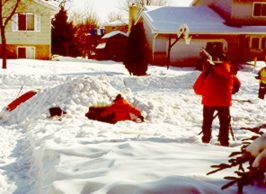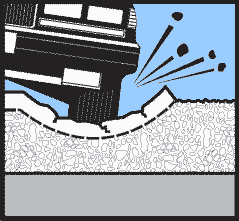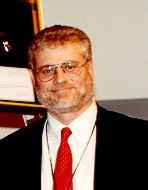 |
 |







|
 |
 |
 |
 |
 |
 |
 |
 |
 |
 |
|
 |
|
|
 |
 |
 |
Video highlights snowplow dangers for children
|
 |
 |
 |
Mn/DOT
and partners are filming an eight-minute winter safety video to be shown
statewide in 3rd and 4th grade classrooms next fall.
|
Children and snowplows do not mix. That’s the main message of an eight-minute
safety video being produced by Mn/DOT, Ramsey County, the Local Road Research
Board and other partners.
Based on an idea by Scott Jahnke, Ramsey County safety officer, and Kent Barnard,
Communications and Public Relations, the video tells the story of two children
who narrowly escape injury after an alert snowplow operator stops to inspect
their snow fort built too near the street.
The video, being created by Mn/DOT’s Video Unit, will be distributed next fall
to 3rd and 4th grade classrooms statewide to help educate
students about winter safety. A short workbook and activity sheets will accompany
the presentation. In addition, snowplow operators may visit the classrooms to
reinforce the video’s messages.
Wendy Frederickson, transportation generalist, Virginia, is the snowplow operator
in the video.
Additional plans for educating about the potential dangers of snowplows include
sending information home to parents, as well as eventually distributing the
video and educational materials to other Snow Belt states.
Text and photo by Kent Barnard
|
back

|
 |
Maintenance crews gear up for tough season of potholes
|
 |
 |
 |
|
Mn/DOT is attacking
potholes on several fronts, including using the automated patcher to make
repairs as quickly as possible and using Superpave and other advanced
pavement designs to reduce the potential for potholes.
|
Mn/DOT is ready to do all it can to smooth drivers’ paths when the inevitable
pothole outbreaks occur this spring, said Mark Wikelius, Mn/DOT’s state maintenance
engineer.
Potholes are created when the moisture from snow, ice and rain combines with
severe cold to crack the pavement. This allows water to seep in, freeze and
displace paving material. Varying temperatures keep the damaging freeze/thaw
cycle in motion.
"We’re attacking potholes on several fronts," Wikelius said. "In
the short-term, we’re using the automated patcher to make repairs as quickly
as possible. In the long-term, we are expanding our use of Superpave and other
advanced pavement designs that we hope will greatly reduce the potential for
roadway damage caused by potholes."
The automated process uses a truck- or trailer-mounted boom to save time and
money, and to improve safety by reducing the exposure of highway workers to
traffic. Twin Cities and St. Cloud maintenance crews, for example, use the automated
patcher because of its suitability for high-traffic areas.
Mn/DOT’s long-range efforts to extend pavement life include the growing use
of Superpave, a high-performance asphalt pavement design that shows potential
to resist damage caused by the freeze/thaw cycle and the extremes in temperature
that damage pavement, Wikelius said.
The department also invests time in preventing potholes from forming. Preventive
maintenance involves constant pavement monitoring to identify sections of roadway
most prone to potholes, rutting, cracking and other damage. Problem areas are
then scheduled for repairs or resurfacing to minimize future damage to the roadway.
Resurfacing techniques include methods such as traditional crack filling, seal
coating with thin layers of asphalt and micosurfacing, which uses a quick curing
mixture of an asphalt emulsion, a mineral such as Portland cement and aggregate.
Microsurfacing provides a smooth surface repair that will last until more extensive
repairs are needed.
For more information, contact John Garrity, Mn/DOT bituminous engineer, 651-779-5580,
or visit our Web site
on potholes.
By Craig Wilkins
Graphic provided by the Michigan Department of Transportation
|
back

|
 |
Report finds RCA effective but could be improved
|
 |
 |
There’s room for improvement, but a recent study of the Resource Consumption
Application concluded that overall the department’s new timesheet reporting
system is working.
Bottom line: employees are being paid properly.
These are the findings Paul Leegard, project specialist, Management Operations
Group, presented to the Senior Management Team Feb. 27.
Mn/DOT began implementing RCA in 1999 to centralize the collection of data—both
time and materials information—about employee work functions. At that time employees
were using ATS (automated timesheet application), OMS (operations management
system) or paper timesheets. The multiple reporting mechanisms required payroll
administrators and operations staff to spend a great deal of time reconciling
data.
Concerns about RCA implementation prompted SMT to assign Leegard to document
and validate various issues expressed about the system. He talked to more than
100 employees about RCA during the research phase of his project.
"By far the most concerns about RCA expressed by employees relate to the
efficiency of entering data and that some of the functions of the application
are located differently than the employee expected them to be," Leegard
said.
The most important finding of Leegard’s RCA review is that employees are being
paid properly and the data is passed to the systems that need it (e.g., MAPS,
SEMA4). Leegard also determined that:
- RCA could be more efficient and user friendly.
- Reporting of data out of storage systems could be easier.
- Payroll functions and activity codes should be standardized among offices
and districts.
- Management of RCA should be centralized.
- Information technology connection to remote Mn/DOT locations is satisfactory
but should continue to be improved.
SMT formally assigned oversight and operation of the RCA application to the
Office of Financial Management. The Office of Human Resources will be responsible
for determining reporting relationships in the payroll administration policies
area. The Management Operations Group will determine how payroll activity codes
should be established, used and integrated with activity based costing efforts.
To date, about two-thirds of the department’s employees use RCA.
"RCA has been improved and continues to be enhanced to make it more user
friendly. It is an effective application that helps with the collection of the
important information Mn/DOT needs to manage its business," noted Dick
Swanson, director, Financial Management.
For more information, contact Paul Leegard, 651-296-7972. Click here to see
the RCA
report . And watch future issues of Mn/DOT Newsline for tips on how
to make RCA work better for you.
By Donna Lindberg
|
back

|
 |
TSS reorganizes team structure
|
 |
 |
The task force leading Mn/DOT's transition to the transportation specialist
series (TSS) was restructured to continue to implement the department's full
use of the new job classifications. Dan Swanson, Detroit Lakes, now leads the
implementation team.
Committees involved in the transition include:
- Steering Committee—sets the overall direction for TSS.
- Labor Contracts Team—reviews issues requiring union negotiations.
- Administrative Sub-group—develops and communicates various processes
such as certification for snowplow operators, TSS exam reviews, development
of "benchmark" position descriptions, filling job vacancies and communications.
- Training and Development Team—develops means to connect work place
skills with current and future workloads. When business units define their
work needs, the team will determine what skills people in those positions
will need, how the skills are learned and arrange for instructors, classrooms
and so on.
For more information, contact Dan Swanson, 218-846-0492.
By Craig Wilkins
|
back

|
 |
Environmental Services’ Belluck wins national award
|
 |
 |
 |
|
Dave Belluck, Environmental Services, recently received
the Hammer Award for his work on a national advisory committee for hazardous
substances.
|
Dave Belluck, chief toxicologist, Environmental Services, received the Hammer
Award for his work with the National Advisory Committee for Acute Exposure Guideline
Levels for Hazardous Substances.
The Hammer Award was created by former Vice President Al Gore to recognize
efforts to putting customers first, cutting red tape and empowering employees.
Belluck represented Minnesota on the Environmental Protection Agency’s committee,
which has been developing guidelines for exposures to acutely hazardous airborne
chemicals.
A Mn/DOT employee since 1999, Belluck holds degrees in agriculture from Cornell
University and entomology (pesticide toxicology) from the University of Illinois,
Champaign-Urbana.
|
back

|
 |
Litter, Cathy Ashfeld featured in Minnesota Monthly
|
 |
 |
 |
Each year, Mn/DOT removes
enough trash from roadsides to fill the Twin Cities Metrodome twice.
|
Litter really T’s (as in trash)-off Cathy Ashfeld, Adopt-a-Highway coordinator,
Metro Division.
Ashfeld shared her disgust for roadside litter and her zeal for Minnesota’s
Adopt-a-Highway program in an article published this month in Minnesota Monthly
magazine. Accompanied by a photograph representing some of the unusual items
cleared from our state’s highways—including a pair of underwear—she shares her
ideas for a cleaner roadside environment.
And as the snow begins to melt, Ashfeld is busy gearing up for the annual Earth
Day activities in April as well as the resumption of roadside clean-up efforts.
Some new partnerships are in the works this year, Ashfeld said, including one
with the cities of Minneapolis and St. Paul to promote litter prevention and
trash pick-up.
By Kent Barnard
Photo provided by Cathy Ashfeld
|
back

|
 |
Computer help is just a click away
|
 |
 |
Help with your computer desktop or applications is just a mouse-click away.
The new computer user
assistance site is available by going to Mn/DOT's Intranet home page at
http://www2.dot.state.mn.us
and clicking on the "User Assistance" link under Tech Resources and Groups.
You can also follow this link to get directly to the site: http://www2.mo.dot.state.mn.us/irm/userhelp/
or find the site under the "Mn/DOT Web Index" alphabetical listing.
Capitol Complex computer users who used to go to the "T3" site from the Intranet
home page can now access User Assistance - Capitol Complex by clicking on the
word "Central Office" on the Minnesota Map at the bottom of the page. Others
can find their district or MIS support office on the map's appropriate geographic
location.
On the computer user assistance site you also can find links to Microsoft Office
support with tips to help you convert from other applications to Microsoft Word.
The site will soon have information about training opportunities, trouble tickets
and purchasing desktop tools.
If you don't find the link to your MIS office, please send a note to the User
Assistance Contact uaf@dot.state.mn.us
with information about the office you're looking for, and someone will work
with you to make sure it is on the map.
By Ed Krum
|
back

|
 |
Snow storm clean-ups continue to receive thanks from the public
|
 |
 |
Snow removal efforts by Mn/DOT’s maintenance crews in late February have garnered
more thanks from drivers around the state. Here are two recent letters:
- My name is Jim Eberhardt. I live in Lakeville. I want to compliment all
of your workers (who) helped with the clearing of our state's roads during
the storm this weekend. I was thoroughly impressed with the state's ability
to keep our travelers moving and at how quickly this was done. Within about
12 hours Mn/DOT had cleared Cedar Ave., 35E, and 35W. Thank you all for all
your hard work. I would not be able to make it to work without you.
- I just wanted to thank all the drivers and the rest of the people who
kept the roads cleared over the weekend. We had a 7th Basketball tournament
in St. Cloud on Saturday and Sunday and drove up from Lindstrom both days.
The roads were kept in good condition despite all that Mother Nature could
dish out.
Thanks again for the supreme performance.
|
back

|
 |
Mini-academy to be held for project managers
|
 |
 |
A one-day mini-academy to discover and refine tools for successful project
management is being held April 3 at the Four Points Sheraton in Minneapolis.
There is no cost for this class, which is aimed at project managers. Participants
should register for the class before March 23 through their employee development
specialist or office manager. For more information, contact Mollie Zauner, Technical
Support, 651-297-4842, or see the announcement posted on bulletin boards.
|
back

|
 |
Question of the Week: timing is everything
|
 |
 |
Pop quiz:
- Who was president of the United States in 1842? Hint: He succeeded another
president whose son later became president.
- What other government event happened in 1842 that continues to affect the
timing of present-day Mn/DOT activities?
Answers:
- Question #1: John Tyler succeeded William H. Harrison as president. Harrison’s
son, Benjamin, later became president.
- Question #2: See the Question
of the Week
|
back

|
|
 |
|
|


